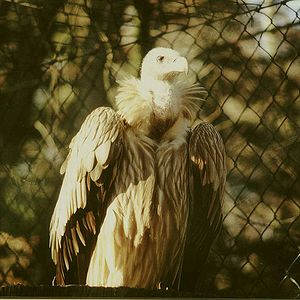Snow vulture
| Snow vulture | ||||||||||||
|---|---|---|---|---|---|---|---|---|---|---|---|---|

Snow vulture ( Gyps himalayensis ) in the Nuremberg Zoo |
||||||||||||
| Systematics | ||||||||||||
|
||||||||||||
| Scientific name | ||||||||||||
| Gyps himalayensis | ||||||||||||
| Hume , 1869 |
The snow vulture or Himalayan egg ( Gyps himalayensis ) is a bird of prey from the subfamily of Old World vultures (Aegypiinae).
features
The snow vulture is characterized by the white, bald head, the white ruff, the yellowish beak, very broad wings and a short tail. It is even larger than the similar griffon vulture ( Gyps fulvus ) and weighs around 8–12 kg. The wingspan is 260-310 cm. The whitish body contrasts with the dark flight feathers.
Food and hunting
The snow vulture feeds on carrion , which it spies from the air in flight. Usually he is not the first on the carcass, but is attracted by the presence of crows and bearded vultures . When eating, it acts aggressively towards competitors, but is inferior to wolves, other predators and also the stronger black vultures. In northern India you can see snow vultures along with griffon vultures and Indian vultures ( Gyps indicus ) on the same carcass.
Reproduction
Like the griffon vulture, the Himalayan egg begins to breed early in the year. The only egg is sometimes laid in December, as both species live in relatively northern latitudes and the time for rearing young is limited by the onset of early winter. Depending on the climate of the inhabited area, the oviposition can also take place later, but no later than May. Himalayan vulture nest in small colonies on cliffs in 1200 m to 4250 m altitude. The clumps , which get bigger over time, come from other birds of prey or are newly created themselves. The young vulture needs between six and eight months from egg-laying to leaving the nest.
Spread and threat
The snow vulture is common in the mountains of Central Asia. It occurs from northern Pakistan and northern India via southern Tibet and Nepal to Bhutan , northern Assam and central China . To the northeast it reaches the Tianshan - and possibly the Altai - and Tarbagatai mountains via the Pamir Mountains . The species usually resides above 1200 m and reaches heights of up to 6000 m above sea level.
Systematics
The snow vulture is sometimes considered a subspecies of the griffon vulture , although both sometimes coexist in the same areas. There are no subspecies of the snow vulture.
literature
- Josep del Hoyo , Andrew Elliot, Jordi Sargatal : Handbook of the birds of the World. Vol. 2: New World Vultures to Guineafowl. Lynx Edicions, Barcelona 1994, ISBN 84-87334-15-6 .
- Helmut Lingen: Large lexicon of animals . Lingen Verlag, Cologne 1989, ISBN.
Web links
- Gyps himalayensis in the Red List of Threatened Species of the IUCN 2008. Posted by: BirdLife International, 2008. Accessed January 31 of 2009.
- Videos, photos and sound recordings about Gyps himalayensis in the Internet Bird Collection
- Snow Vulture, English